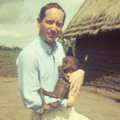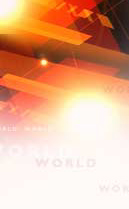


The
World Uncovered
The
World Uncovered is a powerful international current affairs
strand which confronts strong, hard-hitting stories that
affect people’s lives around the world, including exclusive
investigations into the most contentious global issues. In
recent months The World Uncovered has reported from Pakistan,
North America, Central Asia, India, North Korea, Europe, Latin
America, Saudi Arabia, Costa Rica and Thailand.
Saturday
25th September at 0810, 1210 & 1910 GMT
The
most popular of all Indian Godmen, Sai Baba has always been
the "Teflon" God, the untouchable, charismatic man worshipped
by Indian prime ministers, presidents and peasants. His
power over both the influential and the downtrodden goes to
the heart of Indian society and raises serious questions about
the social health of the world's fastest-emerging economy.
Sai
Baba claims to be a living God and to millions, his word is
truth; his ability to bring clean water and healthcare to
thousands, proof of divinity.
In
a programme that explores the nature of belief, The World
Uncovered travels from India to California, where the
generation whose devotion and donations helped Sai Baba to
power are unravelling at the seams. Hard Rock Café owner
Isaac Tigrett sent Sai Baba's message around the world by
making the Godman's Love All Serve All mantra the corporate
slogan of his multi-million empire. He now has to
confront the fact that his God may have been a sexual
abuser.
The
documentary features the story of a family who gave their
entire lives to a man they believed was God, only to discover
he was exacting a terrible price: the sexual innocence of
their son. In an intimate and powerful portrait, a
family talk openly about their betrayal and the man who
controlled their lives.
"The
being which I called Sai Baba, the living God that I had taken
into my heart had been truly abusing my son, for so
long. I felt completely betrayed," says Marissa, a
former devotee. Another, Alaya, says: "I remember him
saying, 'If you don't do what I say, your life will be filled
with pain and suffering'."
This
programme is the first to film inside Sai Baba's Ashram for a
number of years and aims to come closer to the true "face of
God" than ever before.
Ethiopia: A Journey with Michael Buerk
First
transmission - 23rd October 2004
BBC World presents a
powerful documentary in which award-winning journalist Michael
Buerk returns to Ethiopia to see what has happened in the
twenty years since his reports highlighted the devastating
famine there.
Michael talks to many people whose lives have been
permanently scarred by the horrific famine. They speak of how
the suffering has continued while they continue to wait for
the rains, a tragic irony in a country known as the "water
tower of Africa" because it has the biggest natural reserves
of water in the continent.
Michael also follows the story of a young Red Cross nurse
forced to choose which starving people would receive scarce
food aid and be saved, and who would be left to die. Sir Bob
Geldof speaks movingly about his personal crusade to help the
Ethiopian people and the build-up to the Live Aid concert in
1985.
On his recent journey, Michael returned to the towns of
Mekele and Korem and to the highlands, destroyed by civil war
and scorched by drought. Today, the situation is worse and
twice as many people are suffering with starvation.
In 1984 the global response helped to save the people of
Ethiopia, but have our efforts only served to make a terrible
situation worse?
Global
Terror
A season of programmes in which BBC World investigates the
growing threat to the World from the perpetrators of terror.
The Third World War
The most authoritative and revealing account of the secret
war between the Western intelligence agencies and al-Qaeda's
networks. Soon after 9/11, it became clear that a global enemy
could only be countered by a global response. That would mean
unparalleled international co-operation and, critically, the
sharing of intelligence between governments and
counter-terrorism agencies. This series focuses on the
response of the United States, Western Europe and South East
Asia - with unprecedented access to British and American
intelligence agencies across the world and to the terrorists
themselves, including an interview with the four Bali
bombers.
Al-Qaeda: The Hidden Enemy - First transmission -
13th November 2004
Ten months before al-Qaeda’s attacks
on September 11th, Europe’s intelligence agencies foiled a
plot in Frankfurt to bomb Strasbourg’s Christmas market. It
would have been mass murder at the heart of Europe. The cell
was broken and four Algerians were arrested. An MI5 telephone
intercept indicated that the cell’s links went back to the
United Kingdom. The alleged ringleader, Salim Boukari, lived
in England for almost 10 years. In an exclusive interview in
his German jail, he tells reporter Peter Taylor how he became
radicalised in London, trained in Afghanistan to fight his
Jihad, and planned to detonate the Strasbourg bomb.
As Europe’s intelligence agencies and the FBI further
unravelled the connections of the Frankfurt cell, they
discovered it was part of an international network stretching
from Europe to Canada and the USA and back to al-Qaeda’s
training camps in Afghanistan. Frankfurt was a wake-up
call.
With unprecedented interviews with FBI counter-terrorist
chiefs and agents from Europe’s intelligence and security
services, The Third World War reveals how this global network
was uncovered and how it evolved new structures in response to
the inroads made by counter-terrorist agents spanning the
globe. “These structures are rather like the development of
Aids,” says France’s leading terrorist hunter, Jean Louis
Brugiere. “At a given moment, you have one configuration, but
this virus is totally mutant.”
Al-Qaeda: The Hunt for America’s Sleeper Cells -
20th November 2004
In the days after the 9/11 attacks,
as America woke up to the fact that an al-Qaeda cell had been
operating undetected inside the country for months, the FBI
set up the Joint Terrorism Force. Its brief was to track down
al-Qaeda terrorists before they could launch even more deadly
assaults.
The FBI compiled a list of everyone connected to the
hijackers. An intelligence tip off from an al-Qaeda related
trial in Jordan, produced the name Nabil al-Marabh – a Syrian
who had trained in Afghanistan. When the FBI examined his file
they found he had recently tried to smuggle himself across the
Canadian border into the United States. Alarm bells rang. His
profile fitted that of a possible al-Qaeda terrorist. The hunt
for a possible sleeper cell began.
The FBI traced al-Marabh to a flat in Detroit. Inside were
three young men – two Moroccans and an Algerian. But what
stunned them most was the contents of the flat – forged
passports, sketches of a US air base in Turkey, and security
passes for the local airport. They also found a video that
appeared to be a recce of possible targets – including
Disneyland’s Indiana Jones underground ride. The FBI worked
fast and tracked down their associates to see if they were
part of an al-Qaeda network. Gradually, the agents fitted the
pieces together. They became convinced that, for the first
time, they were uncovering an al-Qaeda cell at the heart of
America.
Just 350 miles away, the Buffalo JTTF had another
possible cell under surveillance. But whereas the Detroit cell
consisted of rootless recent immigrants, the six young men in
Buffalo were all American citizens. Most were graduates of the
local High School and stars of the soccer team. One of them
had been voted Most Popular Boy in Class and had married his
High School sweetheart - a non-Muslim.
The film examines not only the critical role of the FBI’s
Joint Terrorism Task Forces in the War against Terrorism but
also the ultimate challenge for a liberal democracy – how to
fight the ‘enemy within’ without riding roughshod over civil
liberties and establishing an all seeing and all knowing
‘surveillance state’ which could change America for ever.
Al-Qaeda: The Breeding Ground - First transmission
27th November 2004
“I thought the more bombs I
delivered, the more I’d be rewarded in the afterlife.” This is
how Ali Imron, one of the three brothers who bombed Bali,
excuses his role in killing 202 tourists in two nightclubs on
the Indonesian paradise island. He now regrets bringing Hell
to this Heaven on Earth. But his two brothers, who face the
firing squad, do not.
All were hunted down as the result of a remarkable joint
investigation by the Bali police chief, General Made Pastika,
and Graham Ashton of the Australian Federal Police. This
painstaking investigation is chronicled, piece by piece, with
exclusive access to the two chief investigators and their
teams.
In interviews with the bombers on Death Row, they describe
with chilling candour how they planned and executed the worst
terrorist atrocity since 9/11. These Muslim fanatics, fighting
their Holy War against the West, could have been stopped. But,
because of a catastrophic intelligence failure, they were not.
The intelligence came from a new, young al-Qaeda recruit whose
code-name was “Sammy”. “Sammy” was hunted by the CIA and
finally tracked down to Oman. Interrogators discovered, to
their amazement, that “Sammy” was not a hardened, experienced
al-Qaeda terrorist but a 19-year-old Canadian student, Mohamed
Jabarah, fresh out of High School in a sleepy Canadian town.
He was taken to a secret location in New York where he told
his FBI interrogators everything. The Third World War gains
exclusive access to his full 26-day interrogation.
One Day of War (2 parts)
First transmission -
18th December 2004
Every minute, two people are killed
in conflicts around the world - but very little is known about
the people who are fighting and dying. One Day Of War follows
individual fighters in 16 of these wars, over a single 24 hour
period.
The film reveals often shocking stories of the modern world
at war. It gets behind the headlines and provides a revealing
portrayal of the people who fight for their land, their
religion, their ideas and, sometimes, simply for survival.
These people reveal their reasons for fighting and their hopes
for the future to paint an intimate portrait of the fear, the
excitement and, often, the sheer banality of life at war.
The people followed by the programme’s cameras are diverse
and engaging. They are fighting in widely different conflicts
and, on the day in question, experience very different
conditions and emotions. The stories include:-
Shushila, a 24-year-old Maoist rebel on her first active
mission in Nepal. She is learning to lay a pipe bomb. Shasila
is “sad to kill anyone” – but is prepared to do it for her
cause.
The Hmong people, who have not seen foreigners for 29
years. During the Vietnam War, Song Cha and his people
collaborated with the Americans and now the Laos Government is
hunting down their village of 200 people through the jungle.
Twenty-nine years on, the sight of foreign journalists wanting
to hear their story brings the entire village to tears.
Mukhtar was orphaned in the war 10 years ago in Somalia. He
was brought up by one of the country’s numerous militias and
is now a 14-year-old “gun for hire”. Mukhtar sleeps rough and,
each day, visits various militia groups, looking for work. On
the day captured in this film, he earned just enough money
patrolling a road block in the morning to be able to buy and
chew the local drug, khat, in the afternoon. Five days after
being filmed, he was shot by his friend and died.
World Review
First transmission - 25th
December 2004
World Review looks back at some of the
main stories of 2004 and focuses on some of the key regional
issues as the year comes to a close.

.gif)




